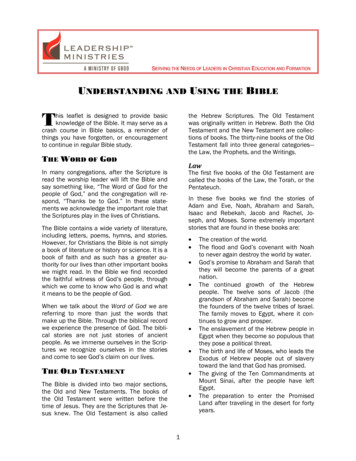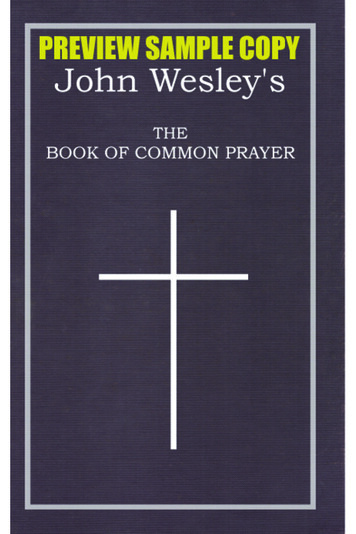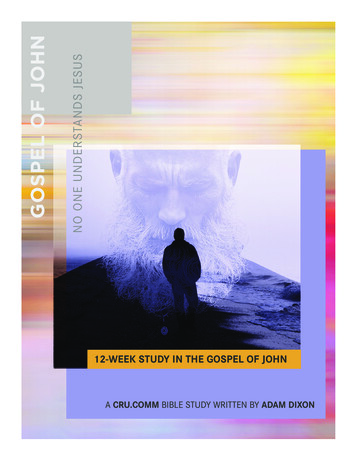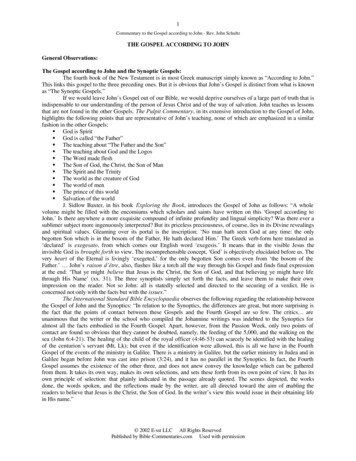
Transcription
WHAT’S THE DIFFERENCE?WhatsTheDifference.SG.07670.i04.indd 14/30/09 1:20 PM
WhatsTheDifference.SG.07670.i04.indd 24/30/09 1:20 PM
WHAT’S THEDIFFERENCE?Manhood and WomanhoodDefined According to the BibleStudy Guide Developed by Desiring GodC R O S S W AY B O O K SW H E ATON, I L L I NOI SWhatsTheDifference.SG.07670.i04.indd 34/30/09 1:20 PM
What’s the Difference?Copyright 2009 by Desiring God FoundationPublished by Crossway Booksa publishing ministry of Good News Publishers1300 Crescent StreetWheaton, Illinois 60187This study guide is based on and is a companion to What’s the Difference? Manhoodand Womanhood Defined According to the Bible (DVD) by John Piper (CrosswayBooks, 2009).All rights reserved. No part of this publication may be reproduced, stored in aretrieval system, or transmitted in any form by any means, electronic, mechanical,photocopy, recording, or otherwise, without the prior permission of the publisher,except as provided for by USA copyright law.Cover photo: Photos.comFirst printing 2009Printed in the United States of AmericaUnless otherwise indicated, Scripture quotations are from the ESV Bible (The HolyBible, English Standard Version ), copyright 2001 by Crossway Bibles, a publishing ministry of Good News Publishers. Used by permission. All rights reserved.Scripture quotations marked nasb are from The New American Standard Bible. Copyright The Lockman Foundation 1960, 1962, 1963, 1968, 1971, 1972, 1973,1975, 1977, 1995. Used by permission.Scripture references marked tniv are from the Holy Bible, Today’s NewInternational Version TNIV . Copyright 2001, 2005 by International BibleSociety . Used by permission of International Bible Society . All rights reservedworldwide.“TNIV” and “Today’s New International Version” are trademarks registered in theUnited States Patent and Trademark Office by International Bible Society .All emphases in Scripture quotations have been added by the author.Trade paperback ISBN: 978-1-4335-0767-0PDF ISBN: 978-1-4335-0768-7Mobipocket ISBN: nce.SG.07670.i04.indd 4159148137612511410309214/30/09 1:20 PM
CONTENTSIntroduction to This Study Guide 7Lesson 11: Introduction to What’s the Difference? Manhood andWomanhood Defined According to the Bible 13Lesson 12: Setting the Stage in Culture: The SecularFeminist Impulse 15Lesson 13: Setting the Stage in the Church: The Tragedy ofFeminist Agnosticism 29Lesson 14: Recovering Biblical Manhood andWomanhood 45Lesson 15: Complementarity as God’s Design inCreation 61Lesson 16: Complementarity as God’s Design forMarriage 79Lesson 17: Defining Male Headship According tothe Bible 95Lesson 18: Defining Female Submission According tothe Bible 109Lesson 19: Answering Objections and Questions 127Lesson 10: Male Leadership in the Church 139Lesson 11: Men and Women in Ministry for the Gloryof God 157Lesson 12: Review and Conclusion 173Leader’s Guide 175Appendix A: Six-Session Intensive Option 183Appendix B: Leading Productive Discussions 185WhatsTheDifference.SG.07670.i04.indd 54/30/09 1:20 PM
WhatsTheDifference.SG.07670.i04.indd 64/30/09 1:20 PM
INTRODUCTION TO THIS STUDY GUIDETHE TOPIC OF HUMAN SEXUALITY is as unavoidable asis our own sexual identity as male or female persons. What doesit mean to be a man? What does it mean to be a woman? Aremen and women equal? Are men and women different? Shouldmen and women have distinctive roles within the family or withinthe church? These are questions in contemporary evangelicalismand in our society that need to be answered. The church cannotremain “neutral” on this issue; it must take a stand one way oranother.The issue is important for a number of reasons. Aside from thepractical concerns for parenting, leading the church, relating in amarriage, and responding to homosexuality, the topic of humansexuality is tied to biblical authority and hermeneutics. WayneGrudem explains:In the widely influential blog “Together for the Gospel,” MarkDever, senior pastor of Capitol Hill Baptist Church in Washington, DC, recently wrote:7WhatsTheDifference.SG.07670.i04.indd 74/30/09 1:20 PM
Introduction to This Study Guide“It is my best and most sober judgment that this position[egalitarianism] is effectively an undermining of—a breach in—the authority of Scripture. . . . It seems to me and others (manywho are younger than myself) that this issue of egalitarianismand complementarianism is increasingly acting as the watershed distinguishing those who will accommodate Scripture toculture, and those who will attempt to shape culture by Scripture. You may disagree, but this is our honest concern beforeGod. It is no lack of charity, nor honesty. It is no desire forpower or tradition for tradition’s sake. It is our sober conclusion from observing the last 50 years. . . .Of course there are issues more central to the gospel thangender issues. However, there may be no way the authorityof Scripture is being undermined more quickly or more thoroughly in our day than through the hermeneutics of egalitarianreadings of the Bible. And when the authority of Scripture isundermined, the gospel will not long be acknowledged.”1Throughout this study guide you will have the opportunity totest Mark Dever’s warning, as you will learn about egalitarianismand complementarianism and how each view seeks to support itsunderstanding of masculinity and femininity.Perhaps most importantly, however, the issue of manhood andwomanhood, and male and female roles, is related to the glory ofGod. It is related to our joyful reflections of that glory, created inthe image of God as male and female persons. Therefore, it is ourhope that you will not only come to solid, biblical convictions onwhat it means to be a man or a woman, and a husband or a wife,but also that you will gladly live out this biblical vision to the gloryof God.This study guide is designed to be used in a twelve-session,2guided group study that focuses on the What’s the Difference?8WhatsTheDifference.SG.07670.i04.indd 84/30/09 1:20 PM
Introduction to This Study GuideManhood and Womanhood Defined According to the Bible DVDset.3 After an introductory lesson, each subsequent lesson examines one 25-minute session4 from What’s the Difference? You, thelearner, are encouraged to prepare for the viewing of each sessionby reading and reflecting upon Scripture, by considering key quotations, and by asking yourself penetrating questions. Your preparatory work for each lesson is marked with the heading “BeforeYou Watch the DVD, Study and Prepare” in Lessons 2–11.The workload is conveniently divided into five daily (andmanageable) assignments. There is also a section suggesting further study. This work is to be completed individually before thegroup convenes to view the DVD and discuss the material.Throughout this study guide, paragraphs printed in a shaded box like this one are excerpts from a book written byJohn Piper (or, occasionally another author), or excerptstaken from the Desiring God Web site. They are included tosupplement the study questions and to summarize key orprovocative points.The second section in Lessons 2–11, entitled “Further Up andFurther In,” is designed for the learner who wants to explore theconcepts and ideas introduced in the lesson in greater detail. Thissection is not required, but will deepen your understanding of thematerial.The third section in Lessons 2–11, entitled “While You Watchthe DVD, Take Notes,” is to be completed as the DVD is playing.This section includes fill-in-the-blanks and leaves space for notetaking. You are encouraged to engage with the DVD by filling inthe appropriate blanks and writing down other notes that will aidyou in the group discussion.9WhatsTheDifference.SG.07670.i04.indd 94/30/09 1:20 PM
Introduction to This Study GuideThe fourth section in each normal lesson is “After You Watchthe DVD, Discuss What You’ve Learned.” Three discussion questions are provided to guide and focus the conversation. You mayrecord, in the spaces provided, notes that will help you contributeto the conversation. Or you may use this space to record thingsfrom the discussion that you want to remember.The final section is an application section: “After You Discuss,Make Application.” You will be challenged to record a “takeaway point” and to engage in a certain activity that is a fittingresponse to the content presented in the lesson.Group leaders will want to find the Leader’s Guide, includedat the end of this study guide, immediately.Life transformation will only occur by the grace of God.Therefore, we highly encourage you to seek the Lord in prayerthroughout the learning process. Pray that God would open youreyes to see wonderful things in his Word. Pray that he would grantyou the insight and concentration you need in order to get the mostfrom this resource. Pray that God would cause you not merely tounderstand the truth, but also to rejoice in it. And pray that thediscussion in your group would be mutually encouraging and edifying. We’ve included objectives at the beginning of each lesson.These objectives won’t be realized without the gracious work ofGod through prayer.NOTES1. Mark Dever, as quoted by Grudem in Evangelical Feminism: A NewPath to Liberalism? (Wheaton, IL: Crossway, 2006), 18–19. See Grudem’s footnote for the bibliographic information.2. While this study guide is ideally suited for a twelve-session study, it ispossible to complete it in six sessions. For instructions on how to usethis study guide for a six-session group study, turn to Appendix A:Six-Session Intensive Option.10WhatsTheDifference.SG.07670.i04.indd 104/30/09 1:20 PM
Introduction to This Study Guide3. Although this resource is designed to be used in a group setting, it canalso be used by the independent learner. Such a learner would have todecide how to use this resource in the most beneficial way. We wouldsuggest doing everything but the group discussion, if possible.4. Twenty-five minutes is only an approximation. Some sessions arelonger; others are shorter.11WhatsTheDifference.SG.07670.i04.indd 114/30/09 1:20 PM
WhatsTheDifference.SG.07670.i04.indd 124/30/09 1:20 PM
LESSON 1INTRODUCTION TO WHAT’S THE DIFFERENCE? MANHOODAND WOMANHOOD DEFINED ACCORDING TO THE BIBLELESSON OBJECTIVESIt is our prayer that after you have finished this lesson . . .› You will get a feel for how you and others in your groupapproach the issue of manhood and womanhood.› Your curiosity would be roused, and questions wouldbegin to come to mind.› You will be eager to learn more about how you can liveyour life to the glory of God as a man or as a woman.ABOUT YOURSELF1) What is your name?2) Tell the group something about yourself that they probablydon’t already know.3) What are you hoping to learn from this group study?13WhatsTheDifference.SG.07670.i04.indd 134/30/09 1:20 PM
WHAT’S THE DIFFERENCE?A PREVIEW OF WHAT’S THE DIFFERENCE?1) What conceptions does our culture have of whatmanhood and womanhood are? What stereotypes ofmanhood and womanhood do you see in movies, ontelevision, in magazines, or on the internet? Accordingto our culture, how does a man express his masculinity?How does a woman express her femininity?2) What, if anything, does the Christian church teach aboutmanhood and womanhood? Do different churchescommunicate different messages about manhood andwomanhood? If so, what are those different messages?14WhatsTheDifference.SG.07670.i04.indd 144/30/09 1:20 PM
LESSON 2SETTING THE STAGE IN CULTURE: THE SECULARFEMINIST IMPULSEA Companion Study to the What’s the Difference? DVD,Session 1LESSON OBJECTIVESIt is our prayer that after you have finished this lesson . . .› You will force yourself to think about definitions ofmanhood and womanhood.› You will grow in discernment regarding our culture’sinfluence on how we think about this subject.› You will gladly reaffirm a commitment to letting the Biblehave the final and determinative say on this subject.BEFORE YOU WATCH THE DVD, STUDY AND PREPAREDAY 1: WHAT IS MANHOOD?In thinking about the sometimes complicated and confusing subject of biblical manhood and womanhood, it is important not to15WhatsTheDifference.SG.07670.i04.indd 154/30/09 1:20 PM
WHAT’S THE DIFFERENCE?lose sight of how basic and relevant this subject really is. JohnPiper exposes how important it is to define manhood in an understandable way when he imagines the question of a little boy: “Dad,what does it mean to be a man and not a woman?”1*QUESTION 1: If your son, or another little boy, asked youthis question, how would you answer him?2A lot of energy is being expended today minimizing the distinctions of manhood and womanhood. But we do not hearvery often what manhood and womanhood should inclineus to do. We are adrift in a sea of confusion over sexualroles. And life is not the better for it.3Notice that the little boy’s question is Question A and notQuestion B.Question A: “Dad, what does it mean to be a man and not awoman?”Question B: “Dad, what does it mean to be a man?”QUESTION 2: Why are the last four words of Question Aimportant? How might the answer to Question A be different thanthe answer to Question B?16WhatsTheDifference.SG.07670.i04.indd 164/30/09 1:20 PM
Lesson 2DAY 2: MANHOOD ACCORDING TOOUR CULTUREOur culture, infected as it is by sin, tends to portray men at one oftwo extremes. John Piper explains:When sin entered the world, it ruined the harmony of marriage NOT because it brought headship and submissioninto existence, but because it twisted man’s humble, loving headship into hostile domination in some men and lazyindifference in others.4QUESTION 3: Which caricature of manhood is more commonly portrayed in our culture—hostile domination or lazyindifference? Which caricature do you think is more commonlyembodied?Even though men are often portrayed in these ways, it is probable that most people in our culture recognize that men shouldnot be either abusive or lazy. Deep down they know that there is abetter way. Study Genesis 1:26–27 and Romans 2:14–15.GENESIS 1:26–2726Then God said, “Let us make man in our image, after ourlikeness. And let them have dominion over the fish of the seaand over the birds of the heavens and over the livestock and overall the earth and over every creeping thing that creeps on the17WhatsTheDifference.SG.07670.i04.indd 174/30/09 1:20 PM
WHAT’S THE DIFFERENCE?earth.” 27 So God created man in his own image, in the image ofGod he created him; male and female he created them.ROMANS 2:14–1514For when Gentiles, who do not have the law, by nature dowhat the law requires, they are a law to themselves, even thoughthey do not have the law. 15 They show that the work of the lawis written on their hearts, while their conscience also bears witness, and their conflicting thoughts accuse or even excuse them.*QUESTION 4: In light of these verses, do you think thatmen and women should have a deep-rooted sense of true masculinity and femininity based on how God created them and the“natural law”? Explain your answer.Distinctions in masculine and feminine roles are ordainedby God as part of the created order, and should find anecho in every human heart.5DAY 3: WHAT IS WOMANHOOD?In Day 1, we considered a question that a little boy might askhis father about manhood. Now consider the question of thelittle girl: “Mom, what does it mean to be a woman and not aman?”618WhatsTheDifference.SG.07670.i04.indd 184/30/09 1:20 PM
Lesson 2*QUESTION 5: If your daughter, or another little girl, askedyou this question, how would you answer her?QUESTION 6: What might be the long-term result ifChristians had no answer to the little girl’s question? What mighthappen if Christians told their sons and daughters that there is noessential difference between men and women?DAY 4: WOMANHOOD ACCORDING TO OURCULTUREThe National Organization for Women (NOW) was established in1966. According to the NOW web site (www.now.org), “NOWis the largest, most comprehensive feminist advocacy group in theUnited States. Our purpose is to take action to bring women intofull participation in society—sharing equal rights, responsibilitiesand opportunities with men, while living free from discrimination.” It has “500,000 contributing members and 550 chapters inall 50 states and the District of Columbia.”19WhatsTheDifference.SG.07670.i04.indd 194/30/09 1:20 PM
WHAT’S THE DIFFERENCE?QUESTION 7: What encounters have you had with modernday feminism? What does feminism teach about womanhood?Two prominent female figures in American culture are BritneySpears and Hillary Clinton. They represent two very differentvisions of womanhood.*QUESTION 8: In the two columns below, list characteristics of these two women as they are portrayed by the media. Whatmight this exercise tell us about how womanhood is depicted inour culture?Britney Spears Hillary ClintonDAY 5: HUMAN SEXUALITY AND BIBLICALAUTHORITYHaving briefly considered what our culture thinks about biblicalmanhood and womanhood, we need to make explicit an assumption that runs throughout this entire study guide: the final authority on human sexuality, masculinity and femininity, and male andfemale roles in the home and in the church is the written Word ofGod, the Bible. We must state this up front because all too often20WhatsTheDifference.SG.07670.i04.indd 204/30/09 1:20 PM
Lesson 2cultural opinions or our own subjective judgments about what’s“beautiful” or “fair” carry more weight than Scripture. Piperoffers us a warning and an exhortation:There’s no point in just talking about what people thinkabout manhood and what people think about womanhood,because there are a thousand thoughts and a thousandopinions in the world. What really matters is what Godthinks about manhood and womanhood—what God appointed for maleness and femaleness. That’s the only thingthat matters in the end. Other things may seem, in the shortrun, attractive, but they will leave you in pain at the end ifthey are not of God.7QUESTION 9: According to Piper, how does joy relate tohuman sexuality?*QUESTION 10: Respond to the following statement:“Why should we believe what the Bible says about human sexuality? So many advances have been made in society and science sincethe Bible was written. And we all know that the Bible was writtenby men who lived in a male-dominated culture. So why should welisten to the Bible on this subject?”21WhatsTheDifference.SG.07670.i04.indd 214/30/09 1:20 PM
WHAT’S THE DIFFERENCE?FURTHER UP AND FURTHER INNote: The “Further Up and Further In” section is for those whowant to study more. It is a section for further reference and goingdeeper. The phrase “further up and further in” is borrowed fromC. S. Lewis.Read “Building Our Lives on the Bible,” an online sermon atthe Desiring God Web site.QUESTION 11: According to Piper, what is the conservativeimpulse in Christianity? What is the liberal impulse?QUESTION 12: How does this sermon relate to our study ofbiblical manhood and womanhood?Listen to “Manhood, Womanhood, and God, Part 4,” anonline conference message by John Piper at the Desiring God Website.8Examine 2 Timothy 4:3–4.2 TIMOTHY 4:3–43For the time is coming when people will not endure soundteaching, but having itching ears they will accumulate for them22WhatsTheDifference.SG.07670.i04.indd 224/30/09 1:20 PM
Lesson 2selves teachers to suit their own passions, 4 and will turn awayfrom listening to the truth and wander off into myths.QUESTION 13: According to Piper, how does this passagerelate to the issue of biblical manhood and womanhood?QUESTION 14: Does strength of conviction equal arrogance? Defend your answer.MATTHEW 10:24–3124A disciple is not above his teacher, nor a servant above hismaster. 25 It is enough for the disciple to be like his teacher, andthe servant like his master. If they have called the master of thehouse Beelzebul, how much more will they malign those of hishousehold. 26 So have no fear of them, for nothing is coveredthat will not be revealed, or hidden that will not be known.27 What I tell you in the dark, say in the light, and what you hearwhispered, proclaim on the housetops. 28 And do not fear thosewho kill the body but cannot kill the soul. Rather fear him whocan destroy both soul and body in hell. 29 Are not two sparrowssold for a penny? And not one of them will fall to the groundapart from your Father. 30 But even the hairs of your head areall numbered. 31 Fear not, therefore; you are of more value thanmany sparrows.23WhatsTheDifference.SG.07670.i04.indd 234/30/09 1:20 PM
WHAT’S THE DIFFERENCE?QUESTION 15: What examples does Piper present of“shrewd” and “politically correct” messages? Can you think ofother similar examples from your own experience?WHILE YOU WATCH THE DVD, TAKE NOTES2 Timothy 3:14–17 (cf. 1:5)What was Ruth Piper like? What kind of mother and wifewas she?What is sexual indd 244/30/09 1:20 PM
Lesson 2“I grew up in a home where I knew my mother’swas not based on lack of .”How are the words “gender” and “sex” used?The assumption of contemporary feminism: Maleness andfemaleness, at the root level of , are negligiblerealities.AFTER YOU WATCH THE DVD, DISCUSS WHATYOU’VE LEARNED1) Think of a man in your life who exhibits true masculinity. What is it about him that makes him truly masculine? Then think of a woman in your life who exhibitstrue femininity. What is it about her that makes hertruly feminine?2) Was biblical manhood and womanhood modeled in thehome in which you grew up? If so, in what ways?25WhatsTheDifference.SG.07670.i04.indd 254/30/09 1:20 PM
WHAT’S THE DIFFERENCE?3) How deep do the distinctions between men and womengo? Are manhood and womanhood at the core of personhood? Or are they superficial and artificial constructions of culture? Or are they something in between?AFTER YOU DISCUSS, MAKE APPLICATION1) What was the most meaningful part of this lesson foryou? Was there a sentence, concept, or idea that reallystruck you? Why? Record your thoughts in the spacebelow.2) Think about ways in which you express your masculinity or femininity. Make a list of masculine or femininebehaviors, thoughts, speech, attitudes, and roles thatyou have adopted. Are these expressions of your sexuality healthy and biblical?26WhatsTheDifference.SG.07670.i04.indd 264/30/09 1:20 PM
Lesson 2NOTES1. This question is reproduced from John Piper, “A Vision of BiblicalComplementarity: Manhood and Womanhood Defined Accordingto the Bible,” in Recovering Biblical Manhood and Womanhood: AResponse to Evangelical Feminism, eds. John Piper and Wayne Grudem (Wheaton, IL: Crossway, 2006), 33. The book Recovering Biblical Manhood and Womanhood is available for free in its entirety atthe Web site of the Council on Biblical Manhood and Womanhood(www.cbmw.org). Please note that the first chapter of this book is alsopublished separately as the book What’s the Difference?2. Questions marked with an asterisk (*) are questions that we deem tobe particularly significant. If your group is completing this study using the six-session intensive option, we recommend that you completethese questions first and then, if time permits, complete the remainingquestions. For more information, see Appendix A: Six-Session Intensive Option.3. John Piper, “A Vision of Biblical Complementarity,” 33.4. John Piper, “Husbands Who Love Like Christ and the Wives WhoSubmit to Them,” an online sermon at the Desiring God Web site(www.desiringGod.org). Throughout this study guide, articles andsermons at the Desiring God web site may be found by performing aTitle Search on the home page.5. This is the second affirmation of the Danvers Statement, which ispublished as Appendix 2 of Recovering Biblical Manhood and Womanhood. It can also be found at the Council on Biblical Manhood andWomanhood (CBMW) Web site.6. This question is reproduced from John Piper, “A Vision of BiblicalComplementarity,” 33.7. John Piper “Manhood, Womanhood, and God, Part 3,” an onlineconference message at the Desiring God Web site.8. This is a conference message available online at the Desiring GodWeb site.27WhatsTheDifference.SG.07670.i04.indd 274/30/09 1:20 PM
WhatsTheDifference.SG.07670.i04.indd 284/30/09 1:20 PM
LESSON 3SETTING THE STAGE IN THE CHURCH: THE TRAGEDYOF FEMINIST AGNOSTICISMA Companion Study to theWhat’s the Difference? DVD,Session 2LESSON OBJECTIVESIt is our prayer that after you have finished this lesson . . .› You will be able to define the terms “evangelical feminism” and “complementarianism.”› You will grasp some of the social effects of feminism.› You will perceive the need for clear definitions of masculinity and femininity.BEFORE YOU WATCH THE DVD, STUDY AND PREPAREDAY 1: MANHOOD AND WOMANHOODACCORDING TO THE CHURCHIn the previous lesson we considered how masculinity and femininity were portrayed and lived out in our culture. In this lesson wewill consider how the church has handled human sexuality.29WhatsTheDifference.SG.07670.i04.indd 294/30/09 1:20 PM
WHAT’S THE DIFFERENCE?*QUESTION 1: What teachings have you heard about manhood and womanhood in the church? Record anything you canremember from sermons you’ve heard, Christian books you’veread, or conversations you’ve had with other Christians.TITUS 2:2–62Older men are to be sober-minded, dignified, self-controlled,sound in faith, in love, and in steadfastness. 3 Older womenlikewise are to be reverent in behavior, not slanderers or slavesto much wine. They are to teach what is good, 4 and so trainthe young women to love their husbands and children, 5 to beself-controlled, pure, working at home, kind, and submissive totheir own husbands, that the word of God may not be reviled.6 Likewise, urge the younger men to be self-controlled.QUESTION 2: According to these verses, do you think thechurch has an obligation to teach what manhood and womanhoodare to the next generation? Explain.30WhatsTheDifference.SG.07670.i04.indd 304/30/09 1:20 PM
Lesson 3DAY 2: EVANGELICAL FEMINISMThe modern American church’s stance toward human sexuality and male and female roles can be described by two basicapproaches. The first may be called “evangelical feminism.” Hereis a rough description of this first approach:Evangelical Feminism: A view shared by evangelicalChristians who believe that God has not assigned differentroles to men and women within marriage and the church.In this view, men and women share a joint authority and responsibility before God for leadership. Men and women areboth qualified to serve as elders within the church. 1 (Thisstudy guide will use “evangelical feminism” and “egalitarianism” synonymously.)It is important to realize that evangelical feminism, especiallyin its advocacy for women preaching pastors, is a new development within church history. Wayne Grudem explains:For the first eighteen hundred years of the history of thechurch, women played influential roles in evangelism,prayer, ministries of mercy, writing, financial support, political influence, private exhortation and encouragementand counsel, and teaching of women and children. Butthey never became pastors of churches, and rarely didthey speak or teach publicly in mixed assemblies of menand women. When women did preach or teach the Bibleto men, it was generally in “sectarian” movements such asthe Quakers. 231WhatsTheDifference.SG.07670.i04.indd 314/30/09 1:20 PM
WHAT’S THE DIFFERENCE?QUESTION 3: Do you know anyone who would considerthemselves an “evangelical feminist”? If so, how have they talkedabout this issue of human sexuality?The major organization promoting evangelical feminism isChristians for Biblical Equality (CBE). Their web site is www.cbeinternational.org. Here is how this organization defines itself:Christians for Biblical Equality is a nonprofit organization comprised of individual and church members frommore than 100 denominations who believe that the Bible,properly interpreted, teaches the fundamental equality ofmen and women of all ethnicities and all economic classes,based on the teachings of Scripture as reflected in Galatians 3:28: “There is neither Jew nor Gentile, neither slavenor free, neither male nor female, for you are all one inChrist Jesus” (tniv).3*QUESTION 4: Can you detect anything in this statementthat might be misleading or potentially manipulative? Explain.32WhatsTheDifference.SG.07670.i04.indd 324/30/09 1:20 PM
Lesson 3DAY 3: COMPLEMENTARIANISMThe second basic approach to human sexuality and roles can becalled “complementarianism.” Here is a rough description of thissecond approach:Complementarianism: A view shared by evangelicalChristians who believe that God has assigned different andcomplementary roles to men and women within marriageand the church. In this view, men bear a unique authorityand responsibility before God for leadership. Only men arequalified to serve as elders within the church.4*QUESTION 5: Do you know anyone who would considerthemselves a “complementarian”? If so, how have they talkedabout this issue of human sexuality?The major organization promoting complementarianism isthe Council on Biblical Manhood and Womanhood (CBMW).Their web site is www.cbmw.org. Here is how this organizationdescribes itself:In 1987, a group of pastors and scholars assembled to ad-dress their concerns over the influence of feminism not onlyin our culture but also in evangelical churches. Becauseof the widespread compromise of biblical understandingof manhood and womanhood and its tragic effects on the33WhatsTheDifference.SG.07670.i04.indd 334/30/09 1:20 PM
WHAT’S THE DIFFERENCE?home and the church, these men and women establishedThe Council on Biblical Manhood and Womanhood.In opposition to the growing movement of feminist egalitarianism they articulated what is now known as the complementarian position which
“TNIV” and “Today’s New International Version” are trademarks registered in the United States Patent and Trademark Office by International Bible Society All emphas











